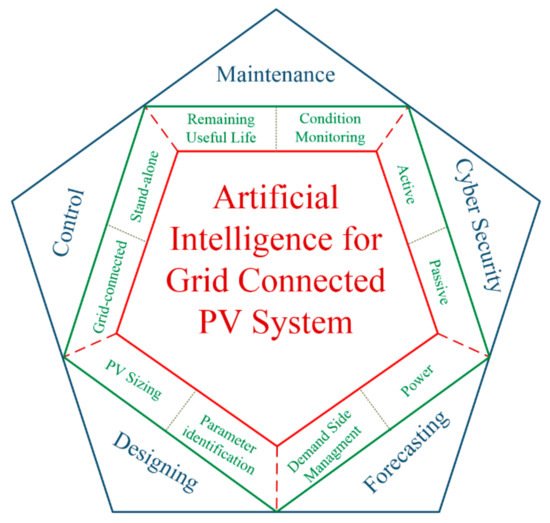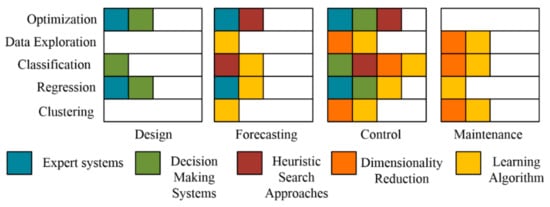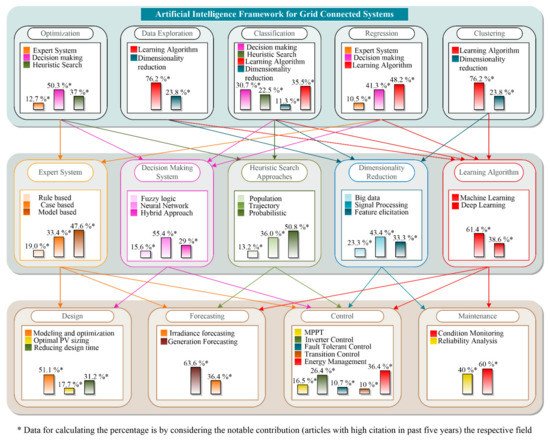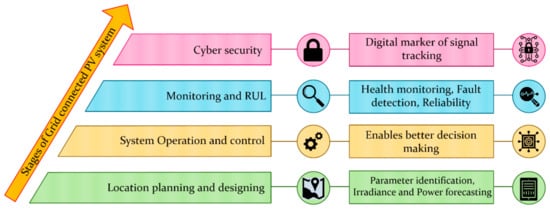The process is extensively used in industries as well as by consumers in their day-to-day activities. Further, the application of AI for the digital transformation of power systems is identified to have massive potential to aid in improving stability, reliability, dynamic response, and other essential advancements for the power system network [
2]. Currently, AI is targeted at implementing the design [
3], forecasting [
4], control [
5], optimization [
6], maintenance [
7], and security aspects of the power system [
8] as illustrated in
Figure 1. Out of these identified areas of AI application, the characteristics of design, forecasting, control, and maintenance are widely discussed in the literature. The elements of cybersecurity are developing and were considered the future trends for AI applications in PV power systems. The data availability in PV power systems’ operation has advanced the development of AI to assist the system learning process in the design, control, and maintenance aspects for improving efficiency and reducing response time. This approach encouraged research activities in a data-driven perspective to analyze the complex and challenging problems in power systems. A layout identifying the techniques between the function and application of AI in power systems is mapped as shown in
Figure 2.
As the application of AI in solar PV is rather extensive, and several papers have reported good results, it must be noted that many of the proposed methods were performed in narrow case studies. These studies indicate that the relative degree of generalization of the models is low and does not produce similar results if applied to a different environment. In the given settings, the AI techniques in
Figure 2 were deployed, and most of the results proved to outperform conventional methods in every applicable section. Another important consideration is the preprocessing of data and data preparation. Every technique is involved with collected time-series data, which will suffer from noise, incomplete datasets and anomalies in the datasets, which is why data preprocessing is the most important task in the utilization of AI. In a survey of about 80 data scientists on how they allocate their time, conducted by CrowdFlower, data preparation accounted for almost 80% of the total time spent [
9]. Thus, making sure that the model can be supplied with clean and valid data is a highly demanding task and is responsible for the performance of the model. Provided that the dataset used is clean and well organized, the training process should be straightforward.
2. AI Framework for Grid Connected Photovoltaic Systems
To analyze the challenges of power systems in the field of design, control, monitoring, forecasting and security, the AI is implemented with different techniques. From the literature, AI for power systems is categorized into five classes: optimization, data exploration, classification, regression, and clustering. Figure 3 identifies the number of publications related to AI in the power system over the past few decades. The data were prepared, using the notable contributions from different journals.
Figure 3. AI framework for different functions, and techniques in application with grid-connected PV systems.
It can be identified that in recent years, most of the researchers have been developing AI techniques for system design optimization and control applications. In [
10], intelligent PV plants are designed, using linear programming based optimization for sizing of PV arrays and energy storage systems (ESS), and model predictive control for controlling the system. Further, in [
11] optimization-based approaches are used for controlling the power system operation by solving the optimal power flow (OPF) problems. The contribution of optimization-based approaches is also extended to reliability analysis of the power system, due to their improved capability in modeling complex problems at low cost. In [
12], the network topology optimization (NTO) technologies along with the dynamic thermal rating (DTR) are used to increase the transmission assets and enhance power system reliability. Subsequently, in [
13] the stochastic dual dynamic programming along with Monte Carlo methods are implemented for optimal reliability planning. In [
14], a robust optimization model for generation and transmission is developed to identify and mitigate the effects of uncertainties and interferences on the reliability of the system.
Further, with increasing access to the operating data of power system, AI implementation has seen a significant rise along with improved accuracy. Here, the data acquired are used to enable learning approaches with AI for identifying various complications and abnormalities in the system and taking an appropriate action within the stipulated time. In [
15], a data-driven approach with a Bayesian ascent algorithm is implemented to achieve the target result by assigning target values for a wind farm operation. Further, the irradiance forecasting with the long short-term memory network is implemented in [
16] for estimating the day-ahead mission profile for PV system operation. Theoretically, a mission profile handles the dataset related to environmental factors of a location (irradiance, temperature, humidity, etc.), energy estimation, annual power generation, and other graphical results. This dataset helps the PV system designers in identifying the operating conditions of the PV, and assists in extracting minimum, average, and maximum power outputs. Further, the authors in [
17] develop a data-driven approach for power system security, to facilitate the identification of the false data injection in the system control. The research identifies that this process can be performed in online mode with the assistance of reinforcement learning approaches.
As most of the power system operation is reliant on processing large amounts of data in a short time, data management and classification facilitate accurate identification of the different operating stages and parameters. In [
18], the real-time characteristics of the power system are monitored to classify different operating stages and identify disturbances in the system. Further, in [
19], an expert system analysis is performed in the power system for distinguishing different voltage dips and interruptions. In [
20], the PV module condition monitoring is achieved by accumulating different failure conditions of the PV panels to create a database and perform a real-time assessment with the trained database. Further in [
21], the normalized peak amplitude and phase at a sampled instant is identified using a Fourier linear combiner, and the data are used for diagnostics with the help for fuzzy systems.
Moreover, to emphasize the full potential of the acquired data, regression approaches were adapted for forecasting, demand side management, and power flow analysis for the power system. In [
22], the PV power forecasting is performed, using a genetic algorithm in combination with particle swarm optimization and an artificial neural network. Here, the Gaussian regression is used for determining the influence of input parameters on the output power. Further, to improve the power quality, a gradient descent least squares regression-based neural network approach is developed in [
23]. This approach tends to reduce noise, minimize the harmonics, and compensate for the DC offset to achieve power improvement for both normal as well as abnormal grid operations. In addition to the above, the power flow analysis can also be performed using regression approaches [
24].
Further, to accomplish an efficient modeling of the system with improved performance and operation, the clustering techniques are adapted with the data acquired from the various operating states of the power system [
25]. In [
26], the
K-clustering method is implemented to identify the power requirements by scaling the heterogenous virtual power plants. Here, the distributed dynamic clustering algorithm is implemented for heterogeneous distribution of ESS in the power system. In [
27], the sizing of ESS for PV generation by considering the uncertainty in the power system is optimized, using a multi cluster algorithm. Similarly, different interconnections in a power grid are analyzed, using a hierarchical spectral clustering methodology [
28]. Considering all the above discussed applications, the digital transformation of in grid-connected PV systems with AI is shown in
Figure 4. Further, a brief overview of AI solutions and techniques to overcome the drawbacks of conventional systems in different functions of grid-connected PV systems are summarized in
Table 1.
Figure 4. Digital transformation of grid-connected PV systems with AI.
Table 1. Drawbacks of conventional algorithms for different applications and their solution with AI.
|
Conventional Algorithms
|
Application
|
Advantages
|
Drawback of Conventional Algorithms
|
Solution with AI
|
AI Techniques
|
|
Predictive and stochastic methods
|
Monitoring and Maintenance
|
Simple implementation, Better Interpretability
|
Sensitive to outliers
|
Replace Outliers with a suitable value using Quantile Methods
|
-
Machine Learning
-
Deep learning
|
|
Data Minimization Approaches
|
Maintenance
|
Flexible framework
|
Can only be used with clustering and intelligent approaches
|
Replace data minimization approaches with filtering and normalization approaches
|
|
|
Kernel based approaches
|
Control and Maintenance
|
Uncertainty Quantification,
Better approximation capability,
Computational Efficiency
|
Probabilistic output, long training time
|
Probabilistic outcomes are overcome with predictability, which uses statistics to analyze the frequency of past successful and unsuccessful events, and solves training sets locally to minimize the training time.
|
|
|
Randomized Probabilistic approaches
|
Maintenance
|
Better Interpretability
|
Complex computations, and Probabilistic output with random variables
|
Uses symbolic reasoning to solve complex computations.
|
-
Logical neural networks
-
Decision trees
|
|
Population based methods
|
Design control and maintenance
|
Parallel Capability, Achieved global convergence
|
Complex implementation approach, less convergence speed
|
Achieves pre-training with a pretty small learning rates to achieve fast convergence
|
-
Machine learning
-
Heuristic search
-
Expert systems
|
|
Trajectory based methods
|
Control
|
Simple implementation, Fast convergence
|
Has local optima, and no parallel capability
|
Work on uncertain jump positions and are less susceptible to premature convergence and less likely to be stuck in local optima.
|
|
3. Application of AI for Power System Design
This section presents the current state of AI implementation within the design and optimization of PV systems in regard to the energy yield, costs and permits. Conventionally, numerical simulations based on the equivalent circuit models for solar panels are discussed to describe the system operational performance [
29,
30]. The parameters of these models are found, using analytical or numerical approaches. The issue that arises while employing analytical methods are that several assumptions and approximations are made, which causes model errors. Numerical methods, on the other hand, have proven to be a better solution [
31,
32]. These methods include the Newton–Raphson method, non-linear least squares optimization and pattern search, although these methods are highly computationally demanding. Further, parameter identification was also accomplished, using Markov chains [
33]. These methods require data that cover a large timespan; therefore, in the case that these kind of data are not available, these conventional methods cannot be employed.
4. Application of AI for Forecasting in Grids with Photovoltaic Systems
As an increase in grid-connected photovoltaic (PV) systems has been seen over the last few years, having accurate forecasts for the power production fed into the grid has become more of an important issue. The reason for an increase is primarily because of the reduction in investment costs, which decreased 10–20%
from 2019 to 2021, but also, factors such as incentives, regulations on technical requirements for building works, and other directives have played a role. As this increase is expected to continue for years ahead, the grid-connected PV systems will lead to higher changes in the electricity grid and can create instabilities, due to sudden changes in weather [
53]. Further, the liberalization of the electricity markets has led to the introduction of spot markets for electricity, which played an important role in the balancing of supply and demand. Therefore, generators, retailers, large end customers and communities have to estimate their output and demand accurately. In order to do so, these market players have been using forecasting methods extensively. An overview on the energy market mechanisms and the resulting requirements for forecasts of electricity production by intermittent renewable energy sources is given in
Figure 5.
Figure 5. Overview of forecasting requirements for process energy marketing.
This overview helps in balancing the electricity production and consumption, and establishes the markets for energy and control reserves [
54]. However, the increasing PV has made it more difficult for market players to manage their systems because they typically have difficulties to forecast solar irradiance, and the PV outputs [
55,
56,
57]. Moreover, it is identified from the literature that generators and retailers, who are unable to meet their forecasted output or demand, must turn to the balancing market, where they pay high prices for their imbalances. In light of these issues, efficient forecasting models are considered a major requirement for enhanced market mechanisms.
In the early literature, forecasting outputs were used in several aspects for managing grids with distributed energy resources. However, the majority of the work has focused on load forecasts instead of distributed energy resource outputs [
58]. A variety of research has used load forecasts for better system operation. Apart from the research that only utilizes forecast outputs, there are also studies that focus on forecasting techniques and accuracy in power grids in order to increase the forecast reliability [
59,
60]. This literature has identified that the forecasting has significant dependence on weather, which is a chaotic system. Therefore, it is impossible to forecast what will happen over long time scales, e.g., next season. This motivated the development of intelligent techniques that are dependent on statistical and stochastic models, as they enable long-term planning by providing a broad understanding of how distributed energy resources and loads behave.
5. Application of AI for Power Electronics Converter Control
The control of power electronic converters can be further classified as (a) grid-connected control and (b) standalone control, based on the mode of operation [
92]. A conventional controller comprises a dual cascade loop in which the outer loop controls the power and the voltage of the inverter, whereas the inner loop is responsible for regulating the current and maintaining the power quality [
93].





